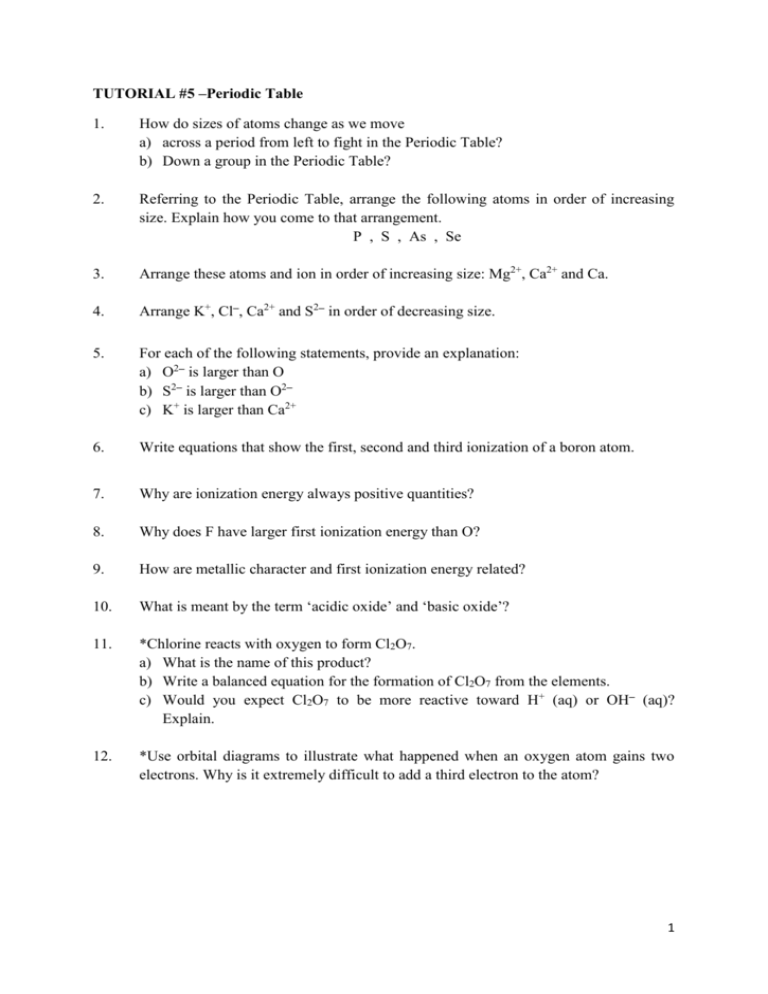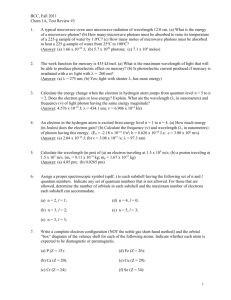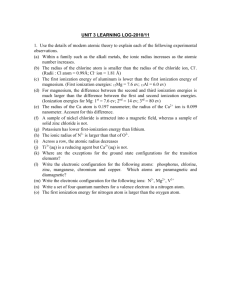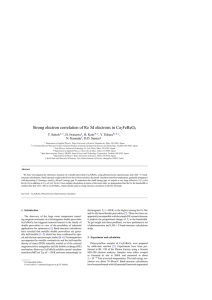Periodic Table Tutorial: Atomic Size, Ionization Energy
advertisement

TUTORIAL #5 –Periodic Table 1. How do sizes of atoms change as we move a) across a period from left to fight in the Periodic Table? b) Down a group in the Periodic Table? 2. Referring to the Periodic Table, arrange the following atoms in order of increasing size. Explain how you come to that arrangement. P , S , As , Se 3. Arrange these atoms and ion in order of increasing size: Mg2+, Ca2+ and Ca. 4. Arrange K+, Cl–, Ca2+ and S2– in order of decreasing size. 5. For each of the following statements, provide an explanation: a) O2– is larger than O b) S2– is larger than O2– c) K+ is larger than Ca2+ 6. Write equations that show the first, second and third ionization of a boron atom. 7. Why are ionization energy always positive quantities? 8. Why does F have larger first ionization energy than O? 9. How are metallic character and first ionization energy related? 10. What is meant by the term ‘acidic oxide’ and ‘basic oxide’? 11. *Chlorine reacts with oxygen to form Cl2O7. a) What is the name of this product? b) Write a balanced equation for the formation of Cl2O7 from the elements. c) Would you expect Cl2O7 to be more reactive toward H+ (aq) or OH– (aq)? Explain. 12. *Use orbital diagrams to illustrate what happened when an oxygen atom gains two electrons. Why is it extremely difficult to add a third electron to the atom? 1 ANSWERS : 1. (a) sizes of atoms decrease (b) sizes of atom increase 2. P and S are in the same period with S located to the right of P: S < P As and Se are also in the same period with Se located to the right of As: Se <As Since As and Se are located below P and S, they have larger sizes Therefore, in order of increasing sizes: S < P < Se < As 3. Cations are always smaller than the neutral atoms: Ca2+ < Ca Ca2+ is located below Mg2+: Mg2+ < Ca2+ Therefore, in order of increasing sizes: Mg2+ < Ca2+ < Ca 4. This is an isoelectronic series of ions with all ion having 18 electrons. Anions are always larger than cations Among the anions, anion with lower charge is larger in size while among the cations, cation with higher charge is smaller in size Therefore, in order of decreasing size: S2– > Cl– > K+ > Ca2+ 5. Answer: a) O2– is larger than O because of the increased repulsion when electron is added. This cause the electron cloud to expand. b) S2– is larger than O2– because S is located below O in the same group and ionic radius increase going down a group. c) K+ is larger than Ca2+ because for isoelectronic ions, the ion with smaller Z has the larger radius. 6. Answer: B(g) B+ (g) + e IE1 B+ (g) B2+ (g) + e IE2 B2+ (g) B3+ (g) + e IE3 7. The electrons in any atom are bound to the atom by their electrostatic attraction to the nucleus. Therefore, energy must be added in order to remove an electron from an atom. 8. Because F has smaller size and the electron is closer to the nucleus, making it more difficult to overcome the electrostatic attraction. 9. The smaller the first ionization energy of an element, the greater the metallic character of that element. 10. An acidic oxide dissolves in water to produce an acidic solution. A basic oxide dissolves in water to produce a basic solution. 2 11. Answer: a) Dichlorine heptoxide. b) 2 Cl2 (g) + 7 O2 (g) 2 Cl2O7 (ℓ) c) Cl2O7 is an acidic oxide; it will be more reactive towards base, OH– (aq). 12. Answer: Ground state configuration of oxygen: O (8e) 1s2 2s2 2p4 ↑↓ ↑↓ ↑↓ ↑ ↑ Configuration after adding two electrons: O2– (10e) 1s2 2s2 2p6 ↑↓ ↑↓ ↑↓ ↑↓ ↑↓ Configuration after adding three electrons: O3– (11e) 1s2 2s2 2p6 ↑↓ ↑↓ ↑↓ ↑↓ ↑↓ 3s1 ↑ The third electron will have to be added to the 3s orbital, which is farther from the nucleus and more strongly shielded by the core (1s2 2s2 2p6). The attraction for the 3s1 electron is not strong enough for O3– to be a stable particle. 3











